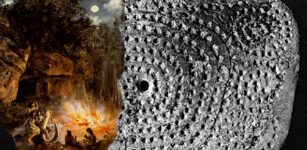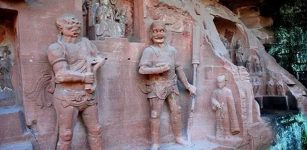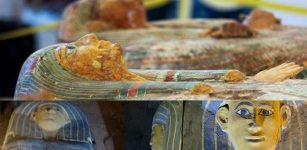Yokai Kijo (Kidjo): Demoness, Cannibal With Hideous Heart Is A Moral Reminder In Japanese Beliefs
A. Sutherland - AncientPages.com - The narratives surrounding the mythical female demons, known as 'kijo', carry a profound moral lesson: women who engage in unethical or immoral conduct risk transforming into malevolent entities that feast on humans.
Image credit: Adobe Stock - cegli 222
Kijo (or Kidjo) is a demoness, a cannibal woman usually wearing rags. In the beautiful beliefs of Japanese people, she is a yokai ("Yōkai") like thousands of other yokai figures.
The younger ones are called "kijo" while the ones that look like old ladies are called onibaba ("demon hag"). Kijo is usually huge but sometimes can be small. They are ugly; their appearance may vary; some of these monsters have (red or yellow eyes, blue skin, sharp horns, long claws, and dirty, matted hair.
These entities possess the extraordinary ability to shapeshift into alternative humanoid forms. As beautiful young ladies, they can be very dangerous trying to charm men. They also exhibit an insatiable craving for human flesh, which can be classified as an addiction. These beings are endowed with various supernatural characteristics that defy conventional understanding.
What did happen to these women?
Vengeful women turn into demons. According to Japanese folk tradition, women who have been betrayed by their husbands or abused or mistreated girls and grandmothers can turn into demons or monsters.
However, the term 'kijo' predominantly refers to females who have undergone a metamorphosis from human beings into monstrous entities, either as a consequence of committing terrible crimes, succumbing to uncontrollable and perilous jealousy, or harboring intense hatred and malice.
The print depicts the herione Kiyohime in distress on the banks of the Hidaka River. Chikanobu Toyohara, The Boatman, 1898. Triptych from the Bamboo Knots (Take no Hitofushi) series. Public Domain
Such highly negative feelings and actions influenced by them undoubtedly corrupt the pure soul. These individuals, having forsaken the rules of polite society, sought refuge in isolated dwellings such as abandoned residences or secluded mountain caverns or even made use of wandering along desolate roads under the veil of darkness.
This yokai's only goal is to continue committing evil deeds. Extremely powerful and dangerous, Kijo demonesses are skilled in the secrets of magic. They are highly capable of casting spells and brewing deadly poisons and potions.
Kijos do not act in groups. Instead, they prefer to act alone and are often driven by personal motives. Japanese legends say that they act either as persecutors of sinners in the underworld or as a threat to human society in the human world.
A particular moral lesson dominates in all stories about the Kijo demoness. It says that women who do bad things can become evil creatures, and men who follow them and succumb to their charm may ruin their lives or encounter their ultimate demise.
There are countless legends of Kijo female monsters in Japanese folklore. Most of them, however, were not created to scare people but as entertainment, warnings, or moral reminders.
Generally, 'Kijo' can be defined as a designation for any demonic or supernatural entity of the feminine gender with malevolent or otherworldly characteristics that can be found within various cultural traditions.
Section of the scroll Dojoji Engi Emaki illustrating the story where the serpent burns the bell killing the monk. Image credit: Unknown author - Dojo-ji engi emaki - Date : Muromachi period (16th) - Wakayama Prefecture, Japan. Public Domain
One of the most famous legends of Kijo demons in Japanese folklore is the tale of Kiyohime. According to this ancient narrative, Kiyohime was the daughter of Shaji, the respected leader of a village. Their family was popular and respected for extending hospitality to travelers passing through their community.
Kiyohime And Unreturned Love
The tale of Kiyohime and Monk Anchin explores the complexities of unreturned love.
Kiyohime, a village maiden, fell in love with a monk, Anchin, who once visited her village. The monk responded to Kiyohime's affections, but it was more on an aesthetic level, admiring her beauty.
Unfortunately, he did not want to pursue a deeper, more passionate connection with the girl. Driven by her intense emotions, Kiyohime decided to pursue the monk, which finally caused a tragic end.
Legend says that the monk escaped to the banks of the Hidaka River, begging the sailors to refrain from helping the girl cross the river. Kiyohime did not want to give up her pursuit. Consumed by her wrath, she decided to swim across the river herself. As she entered the currents, something extraordinary happened. Her fury manifested in a remarkable transformation, causing Kiyohime to assume the form of a serpent.
The monk Anchin saw this and took refuge in a temple, asking the temple to hide him in a bell. It did not help much. Kiyohime followed him and found the bell. Spitting fire through her mouth, she melted the bell and killed the monk. Kiyohime is considered a snake woman who kidnaps men in villages.
Written by – A. Sutherland - AncientPages.com Senior Staff Writer
Copyright © AncientPages.com All rights reserved. This material may not be published, broadcast, rewritten or redistributed in whole or part without thexpress written permission of AncientPages.com
More From Ancient Pages
-
 Secretly Engraved Woman Name Discovered In Medieval Manuscript – Who Was Eadburg?
Archaeology | Dec 3, 2022
Secretly Engraved Woman Name Discovered In Medieval Manuscript – Who Was Eadburg?
Archaeology | Dec 3, 2022 -
 New Light On Prehistoric Chalk Plaques From Stonehenge Using Innovative Technology
Archaeology | Nov 3, 2021
New Light On Prehistoric Chalk Plaques From Stonehenge Using Innovative Technology
Archaeology | Nov 3, 2021 -
 The Invisible Plant Technology Of The Prehistoric Philippines
Archaeology | Jul 1, 2023
The Invisible Plant Technology Of The Prehistoric Philippines
Archaeology | Jul 1, 2023 -
 Fylgja – Norse Guardian Spirit Was Deeply Respected
Norse Mythology | Apr 1, 2024
Fylgja – Norse Guardian Spirit Was Deeply Respected
Norse Mythology | Apr 1, 2024 -
 Historians Search For A Frightening Ancient Underground Secret In One Of Tampa Bay’s Cities
Featured Stories | Sep 1, 2024
Historians Search For A Frightening Ancient Underground Secret In One Of Tampa Bay’s Cities
Featured Stories | Sep 1, 2024 -
 Masroor Temples – India’s Marvelous Ancient Cave Temples
Featured Stories | Jan 23, 2016
Masroor Temples – India’s Marvelous Ancient Cave Temples
Featured Stories | Jan 23, 2016 -
 Fossilized Million-Year-Old Human Skull Of Yunxian Man Excavated In China
Archaeology | Jan 10, 2023
Fossilized Million-Year-Old Human Skull Of Yunxian Man Excavated In China
Archaeology | Jan 10, 2023 -
 Who Were Persian ‘Sparabara’?
Featured Stories | Aug 28, 2017
Who Were Persian ‘Sparabara’?
Featured Stories | Aug 28, 2017 -
 Was Beautiful Ancient City Of Terracina Home To The First Hellenistic Temple?
Archaeology | Dec 16, 2019
Was Beautiful Ancient City Of Terracina Home To The First Hellenistic Temple?
Archaeology | Dec 16, 2019 -
 Astonishing Lunar And Solar Calendars Created 30,000 B.C.
Artifacts | Aug 8, 2017
Astonishing Lunar And Solar Calendars Created 30,000 B.C.
Artifacts | Aug 8, 2017 -
 Prehistoric House Of The Dead Discovered In Wiltshire – Is This The Burial Place Of Ancestors Of Stonehenge Builders?
Archaeology | Jul 17, 2017
Prehistoric House Of The Dead Discovered In Wiltshire – Is This The Burial Place Of Ancestors Of Stonehenge Builders?
Archaeology | Jul 17, 2017 -
 What Is The Curse Of The Ninth Symphony?
Ancient History Facts | Aug 3, 2018
What Is The Curse Of The Ninth Symphony?
Ancient History Facts | Aug 3, 2018 -
 5,000-Year-Old Underground Partly Submerged City Discovered In Turkey’s Cappadocia
Archaeology | Jun 10, 2019
5,000-Year-Old Underground Partly Submerged City Discovered In Turkey’s Cappadocia
Archaeology | Jun 10, 2019 -
 What Is The Meaning Of Ancient Hand Signs We Still Use Today?
Featured Stories | Apr 23, 2025
What Is The Meaning Of Ancient Hand Signs We Still Use Today?
Featured Stories | Apr 23, 2025 -
 Dazu Rock Statues Of Clairvoyance And Clairaudience: Is One Of them Holding A Snake Or ‘Telephone Receiver” In His Hand?
Archaeology | Mar 8, 2017
Dazu Rock Statues Of Clairvoyance And Clairaudience: Is One Of them Holding A Snake Or ‘Telephone Receiver” In His Hand?
Archaeology | Mar 8, 2017 -
 Pharaoh Ramses Was Not One Of History’s Greatest Generals – New Study Ruins His Formidable Reputation
Archaeology | Jan 31, 2018
Pharaoh Ramses Was Not One Of History’s Greatest Generals – New Study Ruins His Formidable Reputation
Archaeology | Jan 31, 2018 -
 The Magnificent Yule Goat In Gävle, Sweden Has Finally Arrived
Christmas Traditions | Dec 2, 2024
The Magnificent Yule Goat In Gävle, Sweden Has Finally Arrived
Christmas Traditions | Dec 2, 2024 -
 Three 3,500-Year-Old Painted Wooden Coffins Discovered In Luxor, Egypt
Archaeology | Dec 3, 2019
Three 3,500-Year-Old Painted Wooden Coffins Discovered In Luxor, Egypt
Archaeology | Dec 3, 2019 -
 Ancient Assyrian Tomb With 10 Skeletons And Ceramic Sarcophagi Unearthed In Iraq
Archaeology | Apr 10, 2017
Ancient Assyrian Tomb With 10 Skeletons And Ceramic Sarcophagi Unearthed In Iraq
Archaeology | Apr 10, 2017 -
 Surprising Discovery Of 88 Ice Age Human Footprints In Utah Desert
Archaeology | Jul 26, 2022
Surprising Discovery Of 88 Ice Age Human Footprints In Utah Desert
Archaeology | Jul 26, 2022



